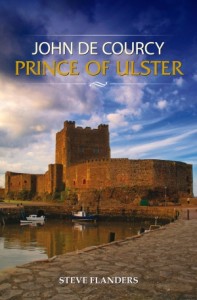Steve Flanders
John de Courcy: Prince of Ulster
(Colourpoint, 2016) 128pp. $8.95
The author of this very brief book is very clear about the purpose of this work: to give the story of John de Courcy, an Anglo-Norman adventurer who carved out a princedom for himself in what is now part of Ulster, and a key aspect of the history of Ireland at the beginning of the period of the Lordship of Ireland at the beginning of English rule over a large part of the island. Those readers who have an interest in Irish history or with the historical origins of the Troubles in Northern Ireland, or with the military history of the Middle Ages as a whole will be interested in the historical subject matter of the book itself. Likewise, the life story of the obscure John de Courcy is useful in understanding the way that the spread of royal power through outsourced invasions of neighboring territory and the complexity of inheritance patterns within the nobility were of great influence in the course of medieval military history.
Even though this book is presented as a biography, it speaks of matters of a broader historical interest. For example, the book not only discusses the details of the life of John de Courcy, but also his family history, the way in which his conquest was supported by a small but cohesive group of land-hungry fellow Anglo-Norman knights and lesser nobles, and the way in which de Courcy sought to consolidate his victories by means of castle-building as well as building towns and giving patronage to the Church as a way of helping to increase the legitimacy of his rule and also the economic viability of his realm against the native Gaelic princes of the region. De Courcy is presented as a man of great military skill and larger strategic thinking, and a certain panache for diplomacy, even if he was ultimately brought to heel as a result of having made powerful enemies like King John of England.
However, although the subject matter of this book is greatly of interest to readers of medieval military history, the book itself has major limitations and is largely useless as a scholarly reference. The most glaring absence in this book is a total absence of cited works, a bibliography, or footnotes or endnotes of any kind. The author clearly has done research, as is indicated by his making comments like the following statement: “Looking at the surviving charters issued by John de Courcy, once we eliminate nicknames and isolated first names, we have about 30 individuals who can be associated with a place of origin. Unsurprisingly, almost all of these came from northern England but a few can be linked to Courcy estates elsewhere (98).” However, despite the fact that the author here alludes to the evidence that would be useful in supporting his conclusions and interpretations about de Courcy’s establishment of rule and support base, these sources are nowhere cited as to where this archival research can be independently verified and found by readers, meaning that the reader has to take the author’s word on what the sources referred to actually say.
Not only does the author show a total lack of interest in citing sources, he also shows a certain weakness when it comes to the logical quality of the arguments he makes, confusing absence of evidence for evidence of absence, as in the following example: “When William fitz Duncan defeated the Lacys at Clitheroe it was because he was fighting to secure his wife’s inheritance, and the fact that no other great lord in the region ever disputed his actions shows they agreed with his move (45).” The combination of these faults makes the book of extremely limited value for those who are looking for research in medieval military history, or indeed any sort of academic or scholarly research, despite the book’s intrinsic appeal when it comes to pleasure reading given its engaging written style and its clearly intriguing historical content.
Even though the book is of extremely limited use as a work of scholarly research, there are ways in which this book shows a great deal of attention to materials to support the book’s historical conclusions. For example, despite the diminutive size of the book, the author provides in the back of the book extensive maps showing the de Courcy estates in England, the de Courcy, fitz Duncan, and Lacy estates in Northern England, the dispositions of the Battle of Downpatrick where de Courcy win his territory in Ulster first, the various realms around the Irish Sea, and the castles build in the lordship of de Courcy, along with the complicated family tree of the de Courcy family showing relationships by blood and marriage and the patronage that de Courcy made to various abbeys and priories. These maps and figures greatly add to the enjoyment of the books, although these resources too come without any citations as to where the information comes from, which would encourage the reader to investigate these sources for themselves.
In the end, how greatly a reader appreciates this book will depend greatly on the purposes they have in reading it. If one reads this book looking for brief but intriguing and thought-provoking book about the life and times and historical content of John de Courcy, this book has much to offer. However, those readers who wish to investigate this history and this time period in an academic and scholarly fashion will find little of research quality here given its absence of listed sources and citations. As a result, this is a book that is aimed only at a low-cost presence as a work of popular history with limited to nonexistent appeal in academic and scholarly contexts.
Nathan Albright
Norwich University
[email protected]

